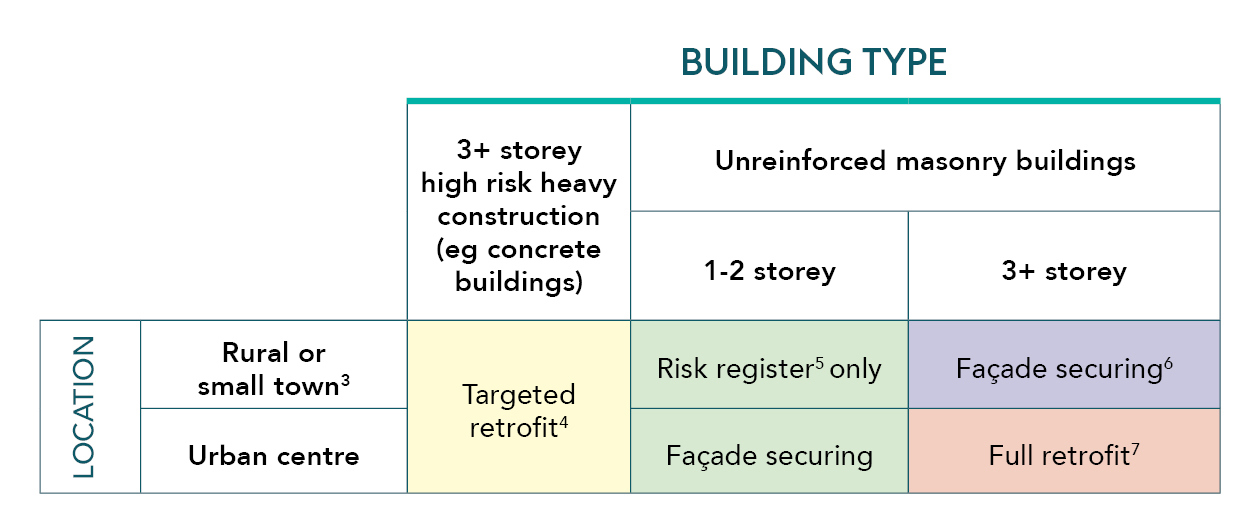After eight years of New Zealand's current earthquake-prone building (EPB) system, the Government has announced a significant and welcome reset, aimed at delivering a fairer, risk-based approach to seismic safety. The changes respond to long-standing concerns from property owners and communities, and are expected to save New Zealanders more than $8 billion in remediation and demolition costs.
Key changes at a glance
1. Disestablishment of the New Building Standard (NBS) model
The current EPB system relied on percentage NBS ratings, which compared the seismic performance of existing buildings to the standard required of a new building in the same location. This approach had been criticised for being both inconsistent and disproportionate, with small changes in ratings potentially leading to major consequences for owners and tenants. The NBS model will be removed, and replacement EPB standards introduced to capture only buildings that pose a more substantive risk to human life in medium and high seismic zones.
2. Regional risk recognition
Under the changes announced, Auckland, Northland and the Chatham Islands will be removed from the EPB regime entirely, reflecting their low seismic risk. Coastal Otago, including Dunedin, will be reclassified as a medium seismic hazard area (up from a low hazard rating).
3. Targeted remediation requirements
Rather than requiring all EPBs to be remediated to at least 34% of NBS, the new system introduces four levels of mitigation, tailored by building type and location:
- Remaining on the public EPB register.
- Façade securing.
- Targeted retrofit.
- Full retrofit.
At a high level, this will result in the following treatment of buildings:

By way of example, three-plus-storey concrete buildings and unreinforced masonry buildings in urban centres will face more stringent requirements. Conversely, smaller buildings in rural areas (under 10,000 people) will not require remediation or warning notices to be displayed and will be able to be removed from the register altogether once the façade of the building is secured. These changes will be particularly welcome in rural centres, which were often disproportionately affected by the existing EPB system.
4. Narrowed definition of priority buildings
Under the current EPB system, buildings of particular usage, post-disaster significance or on major throughfares could be considered "priority buildings", requiring remediation in shortened timeframes. Under the changes announced, only unreinforced masonry that risks pedestrians or vehicles, and buildings that could block emergency routes, will qualify as priority buildings. Hospitals, fire stations and schools will no longer automatically be classified as priority, giving agencies more time to plan seismic upgrades.
5. Greater flexibility for owners
Councils will be able to grant extensions of up to 15 years for remediation deadlines (taken from the date the extension application is received), allowing owners more time to secure funding and plan major works. These extensions will be able to be applied for by owners whose deadlines have previously expired. Seismic work will no longer automatically trigger fire safety or disability access upgrades, and buildings where there is a change of use will only need to meet the new EPB mitigation standard.
Impact on property owners and communities
The impact of the proposed reforms will be significant and are expected to remove around 55% of EPBs - approximately 2,900 buildings - from the system. The Government estimates that about 1,440 buildings will face more cost-effective remediation requirements, and 840 will require no remedial work at all. Only around 80 buildings will still need a full retrofit due to the high risk posed. The Government estimates savings of $8.2 billion in remediation and demolition costs.
For larger or institutional owners and overseas investors, greater certainty around minimum standards will provide a welcome lift in investment confidence. The changes are also expected to reinvigorate communities, particularly in regional towns where previous cost burdens led to empty buildings and stalled investment. By focusing resources on high-risk areas and adopting a more proportionate approach, the new system aims to deliver safer buildings and long-term confidence for owners, tenants and investors.
Implementation timeline
The EPB system changes will be enacted through the Building (Earthquake-Prone Building System Reform) Amendment Bill, which will go through the Select Committee process with time for public consultation, being at least a four-month process. The Bill is expected to be passed into law before the 2026 election. Changes for Auckland, Northland and the Chatham Islands will be immediate upon passage, while other reforms will require further implementation in conjunction with central and local government.
Health and safety
While the EPB changes are welcome, a crucial further area for reform is the overlap between the EPB regime and the Health and Safety at Work Act 2015 (HSW Act). Many of the market behaviours around EPBs, particularly for tenants, have been driven by uncertainty around health and safety liability and the announced EPB changes do not resolve those issues. However, work in this area is underway, with a Cabinet paper confirming an intention to "sharpen the coverage of the HSW Act so that if duty holders comply with relevant requirements under other legislation, like the Building Act 2004, to manage a health and safety risk, the HSW Act does not require a higher standard for the same risk". This clarification would be an important step, and the paper notes that a Bill to give effect to this and other decisions is now being progressed.
The Government has also signalled it will consider further related regulatory relief, including changes to resource management and heritage rules.
For further information or advice on how these changes may affect your property portfolio, please contact the Russell McVeagh team.
Real Estate partner Doran Wyatt is a nationally-recognised expert in seismic building law and was a member of the MBIE-facilitated expert group advising the Government on the proposed changes to the EPB system.



